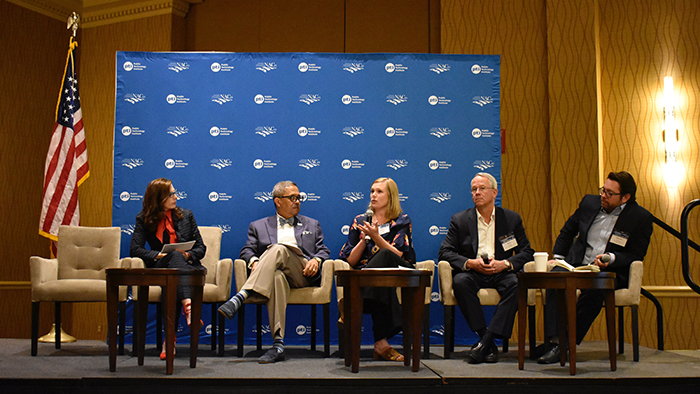NACo 2018: Why Data Sharing Is Essential to Serving the Underserved
Poverty plagues children more than any other group, notes Roy Charles Brooks, president of the National Association of Counties and the commissioner of Tarrant County, Texas. And if county governments do not invest now, they will pay later as poor children grow up and get funneled through the public education, criminal justice and welfare systems.
“We need innovation now more than ever as the equity gap in this country grows even wider,” Brooks said during a panel at NACo’s 83rd Annual Conference and Exposition in Nashville, Tenn. “Every elected official in this room and county staff can develop innovative ways to remove barriers, build opportunities and address the many faces of poverty in America.”
Brooks and other experts on the panel said that county governments need to make data sources about their residents less siloed and use technology to give different departments better access to each other’s data. That will lead to more insights about residents’ welfare and enable counties to more efficiently and effectively deliver services and help the most vulnerable and underserved.
“If we’re going to provide wraparound services to families, agencies and departments need to be able to share data,” Brooks said. “Sometimes, antiquated systems make that a challenging proposition. Sometimes, it’s a cultural issue. But we need help in creating the tools needed to more effectively deliver services.”
SIGN UP: Get more news from the StateTech newsletter in your inbox every two weeks!
How Counties Can Break Down Data Siloes to Help Residents
To share and integrate data more effectively, counties must break down both technical and human siloes, said Della Jenkins, executive director of Actionable Intelligence for Social Policy at the University of Pennsylvania’s School of Social Policy & Practice.
AISP works with counties, cities and states on governance structures that enable different departments to talk with each other and share data, Jenkins said. Counties need to build capacity and relationships within their governmental structures to route and share information more efficiently. “Technology is only as good as the people who are using the technology,” she said.

From left: Stefanie Dreyer, Roy Charles Brooks, Della Jenkins, Barry Murphy and Michael Shaw discuss data at NACo 2018. Photo: Phil Goldstein
Michael Shaw, program officer for human services at the Kresge Foundation, a philanthropic organization that works to expand opportunities in America’s cities, said county governments can get access to a lot of platforms that help analyze data on what is happening in their communities. Yet they face challenges in disaggregating data at the individual level and connecting that to continuous improvement in service delivery models.
Shaw argued that counties need to shift from focusing on outputs to outcomes, and county officials need to do a better job of analyzing data and monitoring contracts and partnerships to get at the problems residents are facing.
Counties should think longitudinally about the data they collect on residents, Jenkins said, and look not just at the experiences and programs they interact with, but how they do so over the course of their life. For example, they could link family members together and use data analytics to explore how the services a mother receives impact her children. To do so, counties need integrated data systems. “We know that the ecosystem kids grow up in impacts them immensely,” Jenkins said. “If parents are thriving, then kids are thriving as well.”
Counties must consider the purpose of the data sharing, integration and analysis they want to do and work backward from that find the technology solution that will help them get there, Jenkins said.
Most counties have a patchwork of software and processes that make their databases talk to each other, according to Jenkins. “There is not one product or solution,” she said. Counties need a range of technical expertise in data analytics, Jenkins noted. Some counties work with outside vendors to get those services or use open-source solutions. Jenkins also said counties should look at their peers for best practices. “Beg, borrow and steal from other places,” she said.
Shaw noted that technology platforms for data analysis often roll down from the federal government to state and local governments, and that this creates a hodgepodge of analytics platforms. These platforms need “become more elastic” so that they can talk to one another, he said.
In just one example of how this can work in practice, Jenkins noted that in Mecklenburg County, N.C., the Institute for Social Capital at the University of North Carolina’s Urban Institute conducted a data analysis. Using descriptive statistics, ISC, in cooperation with Charlotte Mecklenburg Schools, examined whether the school system’s method of capturing whether a student was experiencing homelessness was actually identifying all the children who were considered homeless by the county’s Homelessness Management Information System, according to Jenkins.
ISC discovered that 267 students who were identified by the county as homeless but who were not known to be homeless by the school district. These students were able to then receive additional services using federal McKinney-Vento funding through the school district, Jenkins said.
“They were missing hundreds of kids in the district,” Jenkins said, but that was fixed within two weeks, and the children were enrolled in the additional services.
Follow StateTech magazine's coverage of the NACo 2018 conference at our conference landing page.









